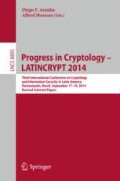Abstract
On top of the passively secure extension protocol of [IKNP03] we build a new construction secure against active adversaries. We can replace the invocation of the hash function that is used to check the receiver is well-behaved with the XOR of bit strings. This is possible by applying a cut-and-choose technique on the length of the bit strings that the receiver sends in the reversed OT. We also improve on the number of seeds required for the extension, both asymptotically and practically. Moreover, the protocol used to test receiver’s behaviour enjoys unconditional security.
Access this chapter
Tax calculation will be finalised at checkout
Purchases are for personal use only
Notes
- 1.
The hidden constant is quite big.
- 2.
\(\mathsf {Bob}\) would learn e.g. the distance of two non-transmitted secrets. It is trivial to check that if two correlated pairs are used by \(\mathsf {Alice}\), then \(\mathbf {x}_i^{(1+b_i)} \oplus \mathbf {x}_j^{(1+b_j)} = \mathbf {y}_i^{(1+b_i)} \oplus \mathbf {y}_j^{(1+b_j)} \oplus \mathbf {l}_i \oplus \mathbf {l}_j\).
- 3.
The purpose of the otherwise seemingly artificial functionality is to give a neat security analysis, both inwardly and outwardly.
- 4.
The cost to pay is increasing the length of the input bit strings to the \(\mathcal {OT}^{}_{}\), using a PRG one would only need to obliviously transfer the PRG seed.
- 5.
The reader can check the relation is reflexive, symmetric and transitive.
- 6.
Parameter \(\ell \) lies in \([\frac{1}{n},1]\).
References
Brassard, G., Crépeau, C., Robert, J.M.: All-or-nothing disclosure of secrets. In: Odlyzko, A.M. (ed.) CRYPTO 1986. LNCS, vol. 263, pp. 234–238. Springer, Heidelberg (1987)
Brassard, G., Crépeau, C., Robert, J.-M.: Information theoretic reductions among disclosure problems. In: FOCS, pp. 168–173 (1986)
Beaver, D.: Correlated pseudorandomness and the complexity of private computations. In: STOC, pp. 479–488 (1996)
Canetti, R.: Universally composable security: a new paradigm for cryptographic protocols. In: FOCS, pp. 136–145 (2001)
Crépeau, C., Kilian, J.: Weakening security assumptions and oblivious transfer. In: Goldwasser, S. (ed.) CRYPTO 1988. LNCS, vol. 403, pp. 2–7. Springer, Heidelberg (1990)
Canetti, R., Lindell, Y., Ostrovsky, R., Sahai, A.: Universally composable two-party and multi-party secure computation. In: STOC, pp. 494–503 (2002)
Crépeau, C.: Equivalence between two flavours of oblivious transfers. In: Pomerance, C. (ed.) CRYPTO 1987. LNCS, vol. 293, pp. 350–354. Springer, Heidelberg (1988)
Crépeau, C.: Verifiable disclose for secrets and applications. In: Quisquater, J.-J., Vandewalle, J. (eds.) EUROCRYPT 1989. LNCS, vol. 434, pp. 150–154. Springer, Heidelberg (1990)
Even, S., Goldreich, O., Lempel, A.: A randomized protocol for signing contracts. Commun. ACM 28(6), 637–647 (1985)
Goldreich, O., Micali, S., Wigderson, A.: Proofs that yield nothing but their validity and a methodology of cryptographic protocol design (extended abstract). In: FOCS, pp. 174–187 (1986)
Goldreich, O., Vainish, R.: How to solve any protocol problem - an efficiency improvement. In: CRYPTO, pp. 73–86 (1987)
Harnik, D., Ishai, Y., Kushilevitz, E., Nielsen, J.B.: OT-combiners via secure computation. In: Canetti, R. (ed.) TCC 2008. LNCS, vol. 4948, pp. 393–411. Springer, Heidelberg (2008)
Ishai, Y., Kilian, J., Nissim, K., Petrank, E.: Extending oblivious transfers efficiently. In: Boneh, D. (ed.) CRYPTO 2003. LNCS, vol. 2729, pp. 145–161. Springer, Heidelberg (2003)
Ishai, Y., Prabhakaran, M., Sahai, A.: Founding cryptography on oblivious transfer – efficiently. In: Wagner, D. (ed.) CRYPTO 2008. LNCS, vol. 5157, pp. 572–591. Springer, Heidelberg (2008)
Impagliazzo, R., Rudich, S.: Limits on the provable consequences of one-way permutations. In: STOC, pp. 44–61 (1989)
Kilian, J.: Founding cryptography on oblivious transfer. In: STOC, pp. 20–31 (1988)
Larraia, E., Orsini, E., Smart, N.P.: Dishonest majority multi-party computation for binary circuits. In: Garay, J.A., Gennaro, R. (eds.) CRYPTO 2014, Part II. LNCS, vol. 8617, pp. 495–512. Springer, Heidelberg (2014)
Lindell, Y., Zarosim, H.: On the feasibility of extending oblivious transfer. In: Sahai, A. (ed.) TCC 2013. LNCS, vol. 7785, pp. 519–538. Springer, Heidelberg (2013)
Nielsen, J.B.: Extending oblivious transfers efficiently - how to get robustness almost for free. IACR Cryptology ePrint Arch. 2007, 215 (2007)
Nielsen, J.B., Nordholt, P.S., Orlandi, C., Burra, S.S.: A new approach to practical active-secure two-party computation. In: Safavi-Naini, R., Canetti, R. (eds.) CRYPTO 2012. LNCS, vol. 7417, pp. 681–700. Springer, Heidelberg (2012)
Peikert, C., Vaikuntanathan, V., Waters, B.: A framework for efficient and composable oblivious transfer. In: Wagner, D. (ed.) CRYPTO 2008. LNCS, vol. 5157, pp. 554–571. Springer, Heidelberg (2008)
Rabin, M.O.: How to exchange secrets with oblivious transfer. IACR Cryptology ePrint Arch. 187 (1981)
Wiesner, S.: Conjugate coding. SIGACT News 15, 78–88 (1983)
Yao, A.C.-C.; Protocols for secure computations (extended abstract). In: FOCS, pp. 160–164 (1982)
Acknowledgments
This work has been supported in part by EPSRC via grant EP/I03126X.
Author information
Authors and Affiliations
Corresponding author
Editor information
Editors and Affiliations
Rights and permissions
Copyright information
© 2015 Springer International Publishing Switzerland
About this paper
Cite this paper
Larraia, E. (2015). Extending Oblivious Transfer Efficiently. In: Aranha, D., Menezes, A. (eds) Progress in Cryptology - LATINCRYPT 2014. LATINCRYPT 2014. Lecture Notes in Computer Science(), vol 8895. Springer, Cham. https://doi.org/10.1007/978-3-319-16295-9_20
Download citation
DOI: https://doi.org/10.1007/978-3-319-16295-9_20
Published:
Publisher Name: Springer, Cham
Print ISBN: 978-3-319-16294-2
Online ISBN: 978-3-319-16295-9
eBook Packages: Computer ScienceComputer Science (R0)

